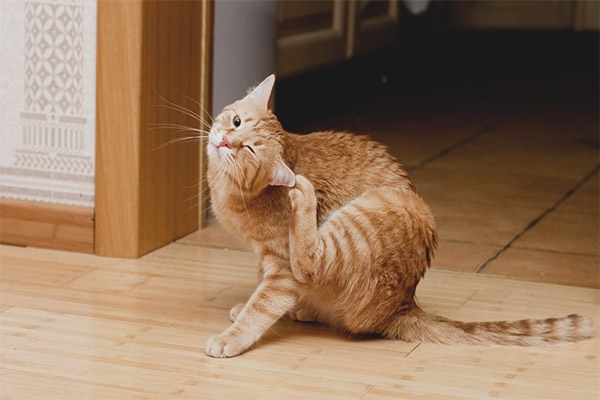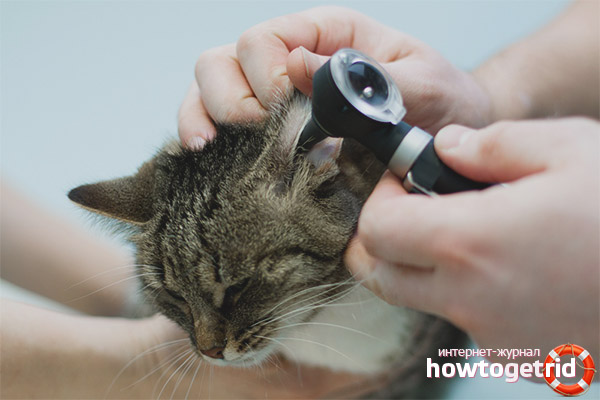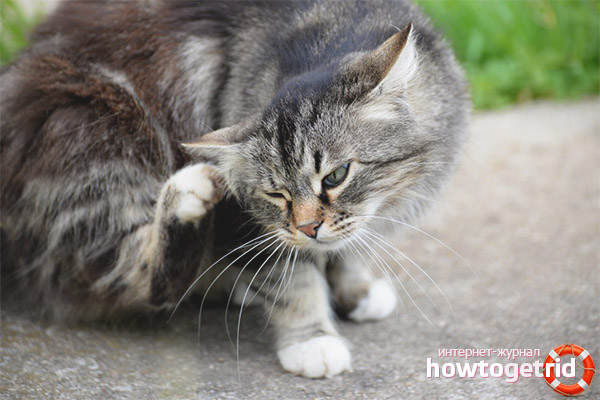The content of the article
Sometimes the owners begin to notice that the cat began to scratch their ears and shake their heads. Those who have a good experience of keeping these animals, everything becomes clear at once. Pet behavior like this can be associated with serious illnesses.
The reasons
In principle, the cat scratches ears all the time. Thus, the pet gets rid of the itch caused by foreign particles, dirt and dust that get into the ears during walks and in living conditions. This is a kind of hygienic procedure that helps the auricles cleanse. It is important to pay attention to how often and how exactly the animal does it.
What should be alerted:
- In the area of the ears and head there is a violation of the skin and inflammation.
- During combing, the pet shows negative emotions: hisses, rumbles, meows.
- Frequent scratching is accompanied by aggression, anxiety, irritability.
- The cat itches without a break, shaking his head. From the side it looks as if she is trying to get rid of a foreign body in the ears.
The reasons for this behavior can be caused by problems of domestic (mechanical) and pathological (physiological) nature.
Mechanical causes
Mechanical often diagnosed by the owners, can be eliminated independently. And, as a rule, rarely accompanied by complications and do not require drug therapy. These reasons include:
- Subsequently, non-compliance with pet hygiene by the owner in the ears has accumulated a lot of sulfur, which the cat can not eliminate on their own.
- Trauma or slaughter of surrounding tissue.
- Hit in the ears of a foreign object.
- After water hygiene procedures or during rain, water has entered the ears.
- Itching is caused by squeezing of surrounding tissues during sleep and the resumption of proper blood circulation.
Pathological causes
Often are dangerous to the health and even the life of the animal. These include:
- Purulent inflammatory processes in nearby tissues.
- Manifestations of skin diseases, eczema or dermatitis.
- The presence of fungal infections.
- Benign and malignant processes in the head.
- Individual allergic reactions to external irritants.
- Blood-sucking parasites: ticks and fleas.
- Inflammation of the ear - otitis.
Such conditions are dangerous to the health and life of the representatives of the cat family. Therefore require consultation and observation of the veterinarian.
Ear Inflammation (otitis)
During otitis, the animal combs its ears to blood, damaging the skin, shakes its head. From the ear ooze out the sulfur, the ichor, purulent discharge is observed. A cat may experience drowsiness and lack of appetite. Inflammation of the ears can be caused by the following factors:
- ticks;
- bacterial infection;
- a combination of the above two reasons.
In the presence of ticks, ear inflammation is a complication. Complex therapy with the use of medicinal drugs Decor, Tsipama, Anandin.
The causes of bacterial otitis is considered the presence of alien organisms in the ears.These include fungal infections, which are aggravated by a decrease in the strength of the immune system and the presence of individual allergic reactions to certain stimuli from the external environment. Treat such conditions with the help of special preparations for external exposure: Mistiate, Otonazole, Aurizole, Clotrimazole. In a state of neglect, antibiotics and pain medications are used. Allergic reactions are blocked by antihistamines.
For inflammation of the ear of a mixed form, Bars, Aurican, Oritzin, Oridermil are used. Exceptions are steroid drugs. They are used only in the most extreme cases, upon the urgent recommendation of the veterinarian, under his strict supervision.
Purulent secretions and sulfur are carefully removed with a cotton swab or disc dipped in hydrogen peroxide diluted with lukewarm water. To increase the body's defenses, the cat is given vitamin-mineral complexes in the form of tablets, suspensions or injections.
Tick-borne diseases
Notoedrosis is one of the most common causes of cat itchiness in the ears.The cause of its occurrence is the penetration of a sarkoptoid tick that infects the ears, the nose area and around the eyes. He bears the danger that his presence can cause damage to the cardiovascular and nervous system of the animal.
Initially, they affect the region of the head and face, and then the rest of the cat's body. Pet feels severe itching in the ears. The skin suffers from severe dryness and irritation, scaly crusts form on them, then they can crack and bleed.
At the initial stages of the disease, sedimentary sulfur, tar preparations, and green soap are used to neutralize the pest. Crusts are removed with warm water and alkaline soap. When launched forms used more "heavy artillery" - benzyl benzoate syrup, hyposulfite solution. If a secondary infection joins the disease, therapy with antibiotics, painkillers, medicines to strengthen the protective functions of the body is indicated.
Ear scabies or otodektoz - is considered one of the most common diseases of domestic animals. It is caused by skin mites, which are very small, for this reason it is extremely difficult to suspect them without the use of additional optical devices.They settle in the ears and inside them. The consequences of their presence are damage to the auditory canals and eardrums. The mite sucks the blood of the cat, which causes severe itching, inflammation and, subsequently, discomfort in the animal.
The pet scratches the auricle area, shaking his head, and makes disturbed sounds. Then crusts and scabs appear on the ears, from which the ichorum stands out. The consequences of this condition are complications such as meningitis, otitis media, and even death.
The disease is treated with antiparasitic drugs aimed at the destruction of blood-sucking parasites for animals. And also used drugs for the treatment of otitis media and antibiotics from a number of tetracyclines.
Sick soft tissue with hematoma
The main symptom is the presence of small swellings in the place where the cat itches. As a rule, after 10-14 days they pass independently. Reduce pain and itching can be using cold compresses and special dressings. In the presence of a large hematoma, the pet needs qualified veterinary care.The doctor opens it and removes the internal contents.
Then the animal is injected with novocaine in combination with antibiotics and hydrocortisone. Intramuscularly make injections with Vikasol. Additionally, physiotherapy can be prescribed.
Fleas
Even individuals that do not have the possibility of independent walking and live in apartment conditions are subject to infection with fleas. The symptom of their presence can be considered constant vigorous scratching ears, as well as other parts of the body.
In such cases, used topical antiparasitic drugs from blood-sucking parasites. They are used for prophylactic purposes and for targeted therapy. These tools include: Frontline, Bars, Stronghold and others. They are drip applied to the withers, where the animal can not reach when licking. Dead fleas are removed by combing with a comb with rare teeth, then the combed hair is removed from the body with a wet hand or a special rubber glove.
Important! If there are other animals in the house, they must also be treated with antiparasitic drugs, even if the pets do not have characteristic symptoms.In the house it is necessary to carry out general cleaning with the use of disinfectants.
Diagnostics
Since itchy ears can be caused by quite dangerous reasons, the pet must be shown to a specialist. Only qualified assistance can completely eliminate them.
The veterinarian conducts an internal examination of the animal and examines the contents of the ears with the help of special optical devices. The cat is assigned additional tests and medical research, depending on the history. Then, drug therapy is described. If indicated, surgical methods may be used.
Preventive measures
Strengthening the pet's immune system is also important, providing a balanced and high-quality diet.It must be diverse, if necessary supplemented with complex vitamins for animals.
Prophylactic vaccinations, deworming and periodically visit the veterinarian in order to prevent should be done in a timely manner.













To send